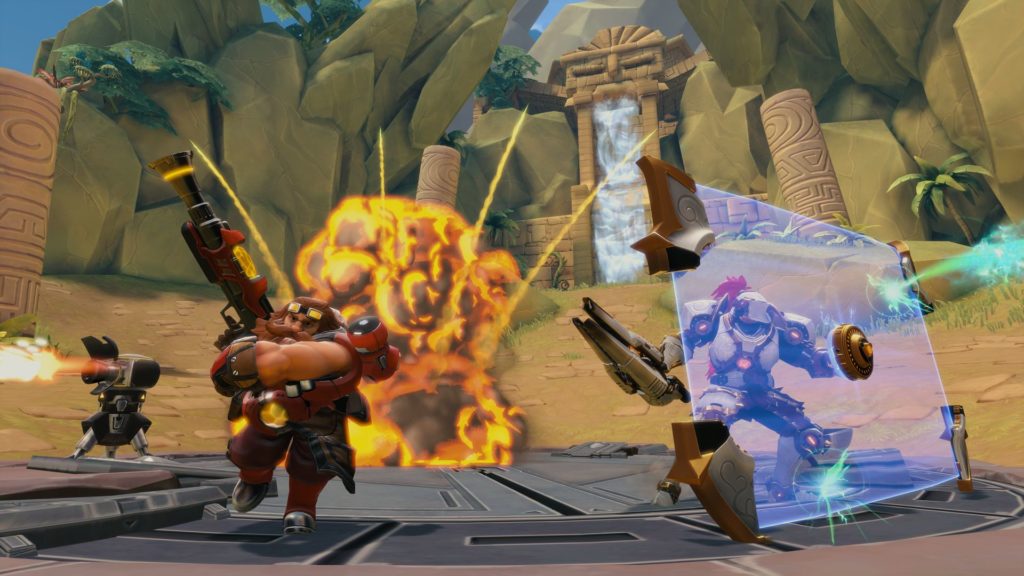Hi-Rez Studios, creators of the hit eSports game Smite, is out to make lightning strike twice with the free-to-play competitive first-person shooter game, Paladins, which launched its open beta on Steam Early Access in September. The game fast became a huge success, with over 100,000 new player accounts created within the first 24 hours, which grew to over 1 million within a week, rocketing the game onto Steam’s Top 10 Games by player count.
Although Paladins is still in development, Hi-Rez took full advantage of the game’s momentum. It recently announced the first ever Paladins Invitational—a global competition that will take place on January 5-8, 2017, where teams battle for a $150,000 prize. Eight teams from around the world will make their way to the Hi-Rez Expo, held in Atlanta, Georgia for the opening matches of the Paladins Invitational, and the finals will be broadcast live from the Cobb Energy Center. Global partners for the event include Level Up, Double Jump and Tencent, which will oversee regional tournaments in Brazil/Latin America, Australia/New Zealand and China respectively. To further promote the eSport, Hi-Rez has begun releasing weekly videos to keep fans informed about how Paladins is progressing.
Todd Harris, Hi-Rez Studios co-founder and chief operating officer, spoke with [a]listdaily about how Paladins is already well on its way to possibly becoming the next hit eSports game.

How would you describe Paladins?
Paladins is a fantasy themed team-based first-person shooter that happens to be free-to-play. If you enjoy multiplayer shooters, enjoy free, and also want to customize each hero around your playstyle, then Paladins might be the game for you.
Why do you think Paladins has found success so quickly on Steam?
A couple of reasons, I think:
First, I think Paladins taps into what a lot of the Steam audience is looking for right now. The most popular games on Steam are multiplayer shooters or MOBAs (Multiplayer Online Battle Arenas). And Paladins actually combines elements of both these popular genres. Paladins is foremost a competitive shooter, but with some elements of a MOBA.
Secondly, Paladins is benefitting from very positive user reviews. The way new game discovery now works on Steam, it is less hand curated and more automated based on positive user feedback and overall playtime. So games that users are enjoying most will get higher visibility on the Steam store.
Paladins is benefitting a lot from that discovery process, and we’ve added an unbelievable 1 million new Paladins players in the first ten days of Steam Early Access.
There are a great number of competitive shooters on the market, including Overwatch. How does Paladins manage to stand out among them?
More customization, more progression, and more frequent content updates.
In many other hero shooters, the ability kit for each champion is fixed. You play each champion a single way with no player customization. In Paladins, we have a system of card collection and deck building that lets you customize each champion around your playstyle.
In terms of progression within the match, we have an item system similar to MOBA games but simplified because, with an FPS, the action is so much faster and the respawn time is lower. The item system allows players to counter other players in interesting ways. So during the match, I can get more resistance against different damage types, or lower my ability cooldowns, or many other stat buffs and adjustments. The item system adds depth and strategy which leads to replayability, especially among competitive players.
Finally, as we’ve learned with Smite, a free-to-play game really benefits from frequent content updates. With Paladins, we update the game with new features and content every two weeks. That schedule is pretty demanding on the development team, but it is also satisfying for us and the player community to see the game improve so dramatically every two weeks.
What convinced you to announce the Paladins Invitational now, when the game is still in open beta?
When building a competitive game, we like to solicit feedback as early as possible from competitive players. Pro player feedback helps our team tune game balance. And we get valuable feedback on the features we’ve built like Spectator Mode, player rankings, leaderboards and the Competitive Queue system.
Hosting a large international tournament like the Paladins Invitational is a great way to attract and reward the competitive players who invest their time in our game.
What lessons did you learn from promoting Smite as an eSport that you will be applying to Paladins?
It is less about promoting the game as an eSport and more about embracing a community-driven development approach, and the competitive player base is just one important segment of the overall community we engage with.
The second big lesson is a focus on sustainability versus being a flash in the pan. We ask ourselves: if a player dedicates his or her time to being the best in the world at our game right now, how are they using those skills one year later?
How did you come to partner with Level Up, Double Jump and Tencent to oversee the regional events?
Within North America and Europe, we operate Leagues ourselves, but we currently work with partners in other regions. Tencent, Level Up, Double Jump and also ESL have supported our operations in other regions with Smite, and they are supporting Paladins operations as well.
We have also recently integrated with FaceIt to put Smite PC and Smite console on their tournament platform to give amateurs a great path toward becoming professional.
What would you say is key to growing a game as an eSport?
It starts with game design. The game itself must have a high skill curve such that expert play can be distinguished from more casual play; that skill curve is a big part of why spectators tune in to watch.
Next comes the focus on sustainability. The top eSports games are basically ‘games as a service.’ The top eSports games have a publisher who is also the developer and is focused upon customer retention as the most important business metric. This retention incentive justifies investing in the game long term rather than doing a few one-off marketing events to drive sales upon initial game release with no follow-up activities. Players have plenty of competitive gaming choices these days. If the publisher is not invested in the game long term, why would a player invest the time and energy to master that game and compete professionally?

